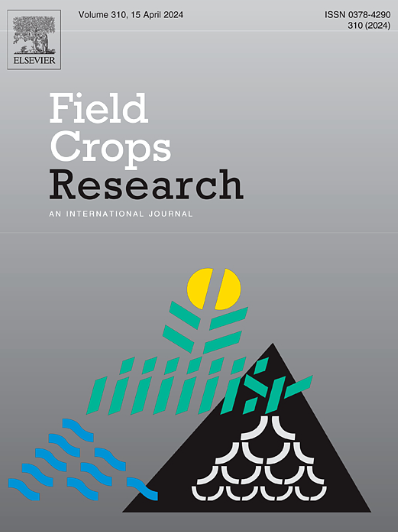气候与遥感数据协同驱动的多任务学习模型在棉花季中产量预测中的应用
IF 5.6
1区 农林科学
Q1 AGRONOMY
引用次数: 0
摘要
棉花产量的准确预测对农业政策、生产管理和粮食安全至关重要。本研究旨在通过明确气候和遥感变量各自的贡献,并确定早期预测的最佳时间窗,提高区域尺度棉花产量估算。我们以中国新疆生产建设兵团8师为研究对象,使用了2021年和2023年的野外调查数据、Sentinel-2A图像和气象记录。采用顺序正向选择和结构方程建模方法选择关键变量。建立了偏最小二乘回归(PLSR)、随机森林和XGBoost模型来估计棉花产量,并评估不同数据组合和时间段的表现。此外,提出了一个多任务学习(MTL)框架,以支持15天间隔时间窗口的动态早季产量预测。结果表明,气候因子通过影响植被状况间接影响产量,而遥感数据对预测精度有显著贡献,尤其是在关键生长阶段。单独的气候数据通常优于遥感数据,尽管它们的组合不断提高模式的精度和稳定性。PLSR在T6窗期(开花结铃期)表现最佳,R2 = 0.60,RMSE = 605.7 kg/ha。MTL模型的准确性随着季节的进展而提高,在收获前60天达到最佳性能(R2 = 0.71, RMSE = 519.7 kg/ha)。我们提供了一个经济、及时、简单的框架,利用公开数据预测区域范围内的棉花产量。研究结果支持改善农业生产管理,并有助于粮食安全举措。本文章由计算机程序翻译,如有差异,请以英文原文为准。
Multi-task learning model driven by climate and remote sensing data collaboration for mid-season cotton yield prediction
Accurate prediction of cotton yield is critical for agricultural policy, production management, and food security. We aimed to enhance regional-scale cotton yield estimation by clarifying the respective contributions of climate and remote sensing variables and identifying optimal time windows for early prediction. We focused on the 8th Division of the Xinjiang Production and Construction Corps in China, using field survey data, Sentinel-2A imagery, and meteorological records from 2021 and 2023. Key variables were selected using Sequential Forward Selection and Structural Equation Modeling. Partial Least Squares Regression (PLSR), Random Forest, and XGBoost models were developed to estimate cotton yields and assess the performance of different data combinations and time periods. Additionally, a multi-task learning (MTL) framework was proposed to support dynamic early-season yield prediction, with 15-day interval time windows. Results showed that climate factors indirectly influenced yield by affecting vegetation status, while remote sensing data contributed significantly to prediction accuracy, particularly during key growth stages. Climate data alone generally outperformed remote sensing data, although their combination consistently improved model accuracy and stability. PLSR achieved the best performance at the T6 window (flowering and boll-setting stage) with R2 = 0.60 and RMSE = 605.7 kg/ha. The MTL model demonstrated increasing accuracy as the season progressed, achieving optimal performance 60 days before harvest (R2 = 0.71, RMSE = 519.7 kg/ha). We provide a cost-effective, timely, and simple framework for predicting cotton yields at a regional scale using publicly available data. The findings support improved agricultural production management and contribute to food security initiatives.
求助全文
通过发布文献求助,成功后即可免费获取论文全文。
去求助
来源期刊

Field Crops Research
农林科学-农艺学
CiteScore
9.60
自引率
12.10%
发文量
307
审稿时长
46 days
期刊介绍:
Field Crops Research is an international journal publishing scientific articles on:
√ experimental and modelling research at field, farm and landscape levels
on temperate and tropical crops and cropping systems,
with a focus on crop ecology and physiology, agronomy, and plant genetics and breeding.
 求助内容:
求助内容: 应助结果提醒方式:
应助结果提醒方式:


